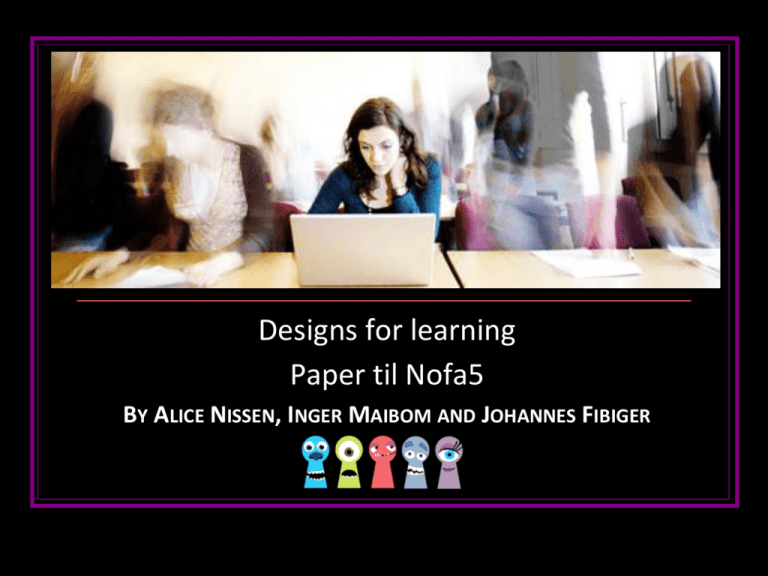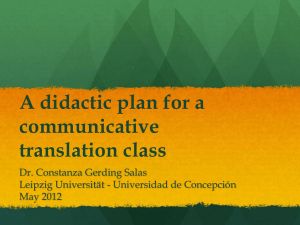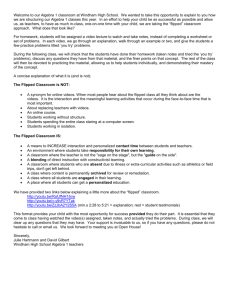Designs for learning
advertisement

Undervisning Designs for learning Paper til Nofa5 BY ALICE NISSEN, INGER MAIBOM AND JOHANNES FIBIGER The Subject Matter • “What is evident is that design is a creative, messy and iterative process. • Teachers rely heavily on prior knowledge and experience in their design practice and rarely follow any kind of formal design method process. • This isn’t problematic in situations where the teachers are working within known parameters, but is problematic when they need to derive new designs within an increasingly complex learning context, where there is an almost infinite number of resources and tools they can draw on.” • (Conole, 2010, NLC) Research question •How do students gain competences in constructing and reflecting on shareable digital designs for learning? Research methods We are doing action research by intervening in common school classes with the purpose of changing the methods in relation to the use and understanding of IT in learning. •The goal is to test and develop shareable didactic designs for learning. •Interventions are conceptualized and then repeatedly implemented in natural settings in order to test and generate new theories and framework for conceptualizing designs for learning. • Designs for learning •Our main goal is to help the students making the design process more explicit and shareable. •Learning design as an area of research and development includes gathering of empirical evidence in order to understand the design process, as well as the development of a range of learning design resources, tools and activities. The Design Metaphor • • • • Design as realization of an intension Design is defined by use and aesthetics Design is founded in the material The design metaphor gets schemes from applied art, architecture and craftsmanship • Design often has container schemes – for instance in relation to content, surface, depth and frame setting • Design often contains construction-metaphors such as scaffolding, building and foundation Phase 1 ● Our project consists of three stages with different focuses. That has led to interesting conclusions. In the first phase (2012-2013) we aimed to strengthen specific learning processes (substitution and augmentation) by integrating technology as a direct tool replacement, without changing the basic form of practice or learning design. ● Replacement means taking digital learning materials in use , that support and facilitate already known , consolidated work practices and methodologies. One of the conclusions of this project was, that the students productions showed no signs of learning in the form of development of a digital educational design. They were, as future teachers, not aware of the crucial didactic choices in the planning of teaching. ● Based on these fledgling experiences and research about Learning Designs introducing the students to a plethora of digital resources and technological learning activities, leaving them alone with the design process, does not create qualified learning design practices. “…it’s not the tech, it’s the teach!”, Davis Muir, Ruben R. Puentedura EdCompBlog Phase 2 •We selected three student groups, who made intervensions primary school classes. •We ‘equipped’ these students with a particular ‘resource-package’, consisting of a number of tools and a loop-model. •Subsequently we examined how the students used these resources in their digital didactic design. Making Movies in two contexts Flipped classroom Phase 3 •Research and practice in learning design aims to make the tacit practices of design for learning explicit, provide (design models), suitable textual, visual representations to support these practices, and suitable tools to manipulate them and them. Conole and Wills (2013). share •A design model is different kinds of pedagogical tools, that helps students entertaining multiple candidate solutions to their design problem. How do we use design learning and design models in our research? •(1) a schedule (fill-in) choices (scripts) based on learning goals, technology and activities (Explicit design choices) •(2) Design task: how to design a LMS-platform - in accordance to specific requirements for a virtual learning environment Requirements for the LMS ● the user (pupils) are able to analyze, produce, edit and manipulate knowledge content on the digital platform. ● the user (pupils) are able to acquire new knowledge together and use the content together (collaborate). ● The teacher (The teacher student) are able to initiate learning processes (workflows) on the platform, and that the process can be controlled and evaluated on the platform. ● The platform must be provided with learning content fx, flipped classroom videos , illustrations or other types of digital learning resources that support the students learning. ● At least three videos should be self -produced (Flipped Classroom) in different formats (educreation, explain everything, webcam, Jing, pocket-film or otherwise) , depending on the learning content. How do teacher student work with Design models? (Eksample 1) How do teacher student work with Design models? (Eksample 2) Video-contend (flipped classrom-videos) made by teacher students Findings •Based on our extensive empirical data ( surveys, collected learning objects , internship reports, focus group interviews and classroom observations ) we can in practice observe how the students are ' thinking ' with selected concepts before, during and after the course. •The fact that they have tested a particular design has made them sharper on framing , choice of technologies, the use of the flipped classroom , and not least the importance of evaluating-loops using John Hatties concepts of feed up , feed back and feed forward. •Students must via the platform have access ( and the opportunity ) to analyze, produce, process and reflect didactically on academic content •The teacher must have a formal basis in order to start learning processes on the platform, and be able to control and evaluate the process via the platform •In advance the platform must be equipped with professional content in the form of texts, Flipped Classroom videos, illustrations or other types of learning resources that support their learning. Conclusion Conclusion Conclusion ● The conclusion of our three -year study is that focus should not be on developing prototypes and testing their robustness because a closed educational design quickly becomes obsolete and does not work in all contexts. ● What is crucial in ICT-based education, is to rethink and develop designs which are specific to target audience, topic, course and not least competence of student learning. ● When students are equipped with IT didactic design models (formal design methods), their IT didactic skills in the subject are trained contributing to a didactic weight shift. Discussion ● How can the knowledge produced by the project about the design concept be implemented prospectively? ● How can ICT-based educational design contribute to the development and innovation of teaching and learning, and how can working with IT didactic design improve teacher training and support the dual perspective of elementary school and teacher training?





